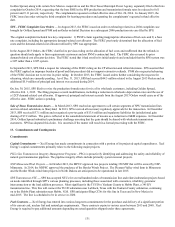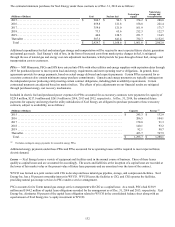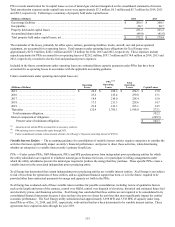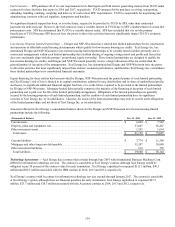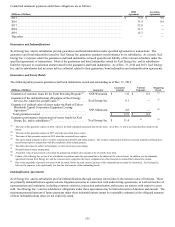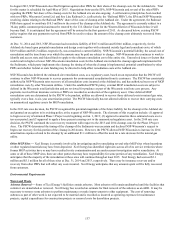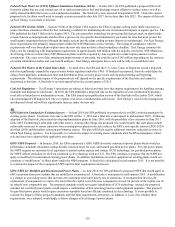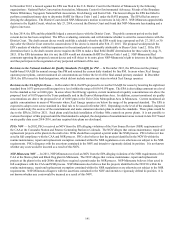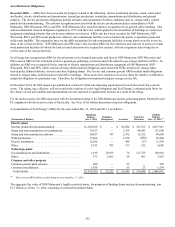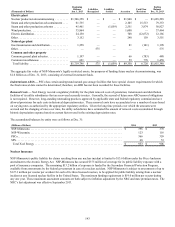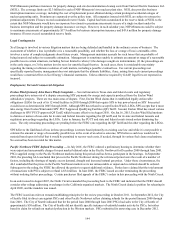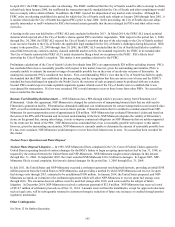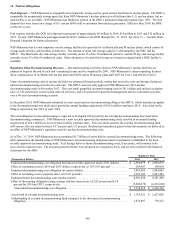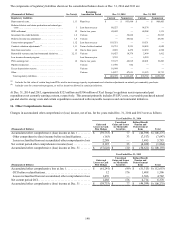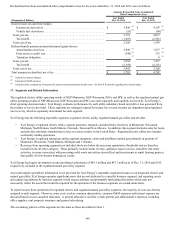Xcel Energy 2014 Annual Report Download - page 157
Download and view the complete annual report
Please find page 157 of the 2014 Xcel Energy annual report below. You can navigate through the pages in the report by either clicking on the pages listed below, or by using the keyword search tool below to find specific information within the annual report.
139
CSAPR — CSAPR addresses long range transport of PM and ozone by requiring reductions in SO2 and NOx from utilities in the
eastern half of the United States using an emissions trading program. For Xcel Energy, the rule applies in Minnesota, Wisconsin and
Texas.
In August 2012, the D.C. Circuit vacated the CSAPR and remanded it back to the EPA. The D.C. Circuit stated the EPA must
continue administering CSAPR’s predecessor rule pending adoption of a valid replacement. In April 2014, the U.S. Supreme Court
reversed and remanded the case to the D.C. Circuit. The Supreme Court held that the EPA’s rule design did not violate the CAA and
that states had received adequate opportunity to develop their own plans. Because the D.C. Circuit overturned the CSAPR on two
over-arching issues, there are many other issues the D.C. Circuit did not rule on that will now need to be considered on remand. In
October 2014, the D.C. Circuit granted the EPA’s request to begin to implement CSAPR by imposing its 2012 compliance obligations
starting in January 2015. In addition, the D.C. Circuit set a briefing schedule and plans to hear arguments on the remaining issues in
the case in February 2015. While the litigation continues, the EPA will begin to administer the CSAPR in 2015.
Multiple changes to the SPS system since 2011 will substantially reduce estimated costs of complying with the CSAPR. These
include the addition of 700 MW of wind power, the construction of Jones Units 3 and 4 to meet reserve requirements and provide
quick start capability, reduced wholesale load and new PPAs, installation of NOx combustion controls on Tolk Units 1 and 2 and
completion of certain transmission projects. As a result, SPS estimates compliance with the CSAPR in 2015 will cost approximately
$7 million.
NSP-Minnesota can operate within its CSAPR emission allowance allocations, particularly given the cessation of coal operations at
Black Dog Units 3 and 4 before mid-April 2015. NSP-Wisconsin can operate within its CSAPR emission allowance allocation for
SO2 due to cessation of coal combustion at Bay Front Unit 5. NSP-Wisconsin anticipates compliance with the CSAPR for NOx in
2015 through operational changes or allowance purchases. CSAPR compliance in 2015 is not expected to have a material impact on
the results of operations, financial position or cash flows.
EGU Mercury and Air Toxics Standards (MATS) Rule — The final EGU MATS rule became effective in April 2012. The EGU
MATS rule sets emission limits for acid gases, mercury and other hazardous air pollutants and requires coal-fired utility facilities
greater than 25 MW to demonstrate compliance within three to four years of the effective date. Xcel Energy expects to comply with
the EGU MATS rule through a combination of mercury and other emission control projects. In 2014, the U.S. Supreme Court decided
to review the D.C. Circuit’s decision that upheld the MATS standard. It is not yet known what impact the Supreme Court’s decision
may have on the MATS standard or its implementation schedule. Xcel Energy believes EGU MATS costs will be recoverable through
regulatory mechanisms and does not expect a material impact on results of operations, financial position or cash flows.
Minnesota Mercury Legislation — NSP-Minnesota installed sorbent control systems at the Sherco Unit 3 and A.S. King generating
plants and completed installation of mercury controls on Sherco Units 1 and 2. Installation costs through Dec. 31, 2014 were $12.9
million for the mercury controls on the units and NSP-Minnesota believes these costs will be recoverable through regulatory
mechanisms.
Industrial Boiler (IB) MACT Rules — In 2011, the EPA finalized IB MACT rules to regulate boilers and process heaters fueled with
coal, biomass and liquid fuels, which would apply to NSP-Wisconsin’s Bay Front Units 1 and 2. The controls to meet the
requirements were substantially complete as of Dec. 31, 2014, with final work targeted to be finished in May 2015. The final capital
cost is estimated to be approximately $21 million.
Regional Haze Rules — The regional haze program is designed to address widespread, regionally homogeneous haze that results from
emissions from a multitude of sources. In 2005, the EPA amended the BART requirements of its regional haze rules, which require
the installation and operation of emission controls for industrial facilities emitting air pollutants that reduce visibility in certain
national parks and wilderness areas. In their first regional haze SIP, Colorado, Minnesota and Texas identified the Xcel Energy
facilities that will have to reduce SO2, NOx and PM emissions under BART and set emissions limits for those facilities.
PSCo
In 2011, the Colorado Air Quality Control Commission approved a SIP (the Colorado SIP) that included the CACJA emission
reduction plan as satisfying regional haze requirements for the facilities included in the CACJA plan. In addition, the Colorado SIP
included a BART determination for Comanche Units 1 and 2. The EPA approved the Colorado SIP in 2012. Installation of emission
controls at Pawnee was completed in 2014 at a cost of $272.6 million. Installation of the emission controls at Hayden Unit 1 is
scheduled for 2015 and Hayden Unit 2 is scheduled for 2016 at an estimated combined cost of $84.6 million. PSCo anticipates these
costs will be fully recoverable in rates.




